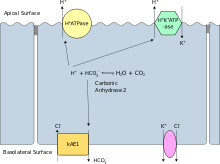Distal renal tubular acidosis
| Distal renal tubular acidosis | |
|---|---|
| Other names | Type 1 Radiograph of a person with rickets , a complication of both distal and proximal RTA. |
Distal renal tubular acidosis (dRTA) is the classical form of RTA, being the first described. Distal RTA is characterized by a failure of acid secretion by the
Symptoms and signs
Because renal excretion is the primary means of eliminating acid from the body, there is consequently a tendency towards
- Normal anion gap metabolic acidosis/acidemia
- Hypokalemia
- Urinary stone formation (related to alkaline urine, hypercalciuria, and low urinary citrate).[3]
- Nephrocalcinosis (deposition of calcium in the substance of the kidney)
- Bone demineralisation (causing rickets in children and osteomalacia in adults)
The symptoms and sequelae of dRTA are variable and range from being completely
dRTA commonly leads to sodium loss and volume contraction, which causes a compensatory increase in blood levels of aldosterone.[4] Aldosterone causes increased resorption of sodium and loss of potassium in the collecting duct of the kidney, so these increased aldosterone levels cause the hypokalemia which is a common symptom of dRTA.[4]
Causes

- systemic lupus erythematosus, rheumatoid arthritis and even hypergammaglobulinemia. Hypokalaemia is often severe in these cases.[5]
- Hereditary causes include mutations of apical proton pump vH+-ATPase,[8] which are transmitted in an autosomal recessive fashion, and may be associated with sensorineural deafness.[9]
- Liver cirrhosis.
- cortical collecting duct.
- Renal transplantation.
- Sickle cell anemia.
- Toxins, including ifosfamide (more commonly causing pRTA than dRTA),[10] lithium carbonate[11] and amphotericin B.[12]
- Chronic urinary tract obstruction.
- Toluene causes a non-anion gap metabolic acidosis with hypokalemia and a positive urinary anion gap that looks a lot like distal RTA but there is no hydrogen secretion defect and the acidosis is due to acid production during the metabolism of toluene.[13]
Diagnosis
The pH of patient's blood is highly variable, and acidemia is not necessarily characteristic of people with dRTA at any given time. One may have dRTA caused by
dRTA has been proposed as a possible diagnosis for the unknown malady plaguing Tiny Tim in Charles Dickens' A Christmas Carol.[17][18]
Treatment
This is relatively straightforward. It involves correction of the acidemia with oral sodium bicarbonate, sodium citrate or potassium citrate. This will correct the acidemia and reverse bone demineralisation. Hypokalemia and urinary stone formation and nephrocalcinosis can be treated with potassium citrate tablets which not only replace potassium but also inhibit calcium excretion and thus do not exacerbate stone disease as sodium bicarbonate or citrate may do.[19]
See also
References
- ^ "Osmosis: Renal tubular acidosis". Osmosis. Archived from the original on 2020-10-20.
- PMID 15778079.
- PMID 2645431.
- ^ ISBN 978-1-4160-6911-9.)
{{cite book}}: CS1 maint: multiple names: authors list (link - PMID 8210309.
- PMID 9312167.
- PMID 10926824.
- PMID 15383652.
- S2CID 34262548.
- S2CID 12624019.
- PMID 3314489.
- PMID 5634966.
- PMID 1912400.
- PMID 23114896.
- PMID 13658353.
- PMID 17410104.
- PMID 1340779.
- ^ "What Ailed Tiny Tim". Time. 1992-12-28. Archived from the original on September 30, 2007. Retrieved 2010-05-22.
- PMID 12138154.
